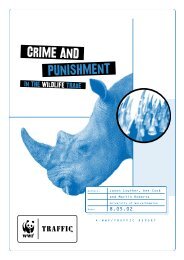In full swing: assessment of trade in orang-utans and ... - WWF UK
In full swing: assessment of trade in orang-utans and ... - WWF UK
In full swing: assessment of trade in orang-utans and ... - WWF UK
You also want an ePaper? Increase the reach of your titles
YUMPU automatically turns print PDFs into web optimized ePapers that Google loves.
identification, we followed the key provided by Geissmann (1995), along with photographic updates (www.gibbons.de)<br />
<strong>and</strong> photographs <strong>in</strong> Rowe (1996). Identification was not always straightforward <strong>and</strong> <strong>in</strong> most <strong>of</strong> the wildlife rescue<br />
centres <strong>and</strong> some <strong>of</strong> the zoos, we consulted staff about the species' identity to confirm our identification or to obta<strong>in</strong><br />
additional <strong>in</strong>formation.<br />
The two species <strong>of</strong> <strong>orang</strong>-utan are generally more easily<br />
identified, although phenotypic variation can be large <strong>and</strong> it is<br />
not always easy to separate the two species. This is true for all<br />
age-classes, although <strong>in</strong> general, the older <strong>in</strong>dividuals are more<br />
easily dist<strong>in</strong>guished. Hence, these problems <strong>in</strong> identification, as<br />
with the gibbons, may somewhat cloud the accuracy regard<strong>in</strong>g<br />
which <strong>orang</strong>-utan species is enter<strong>in</strong>g the <strong>trade</strong> cha<strong>in</strong>. Despite<br />
large morphological <strong>and</strong> genetic differences, the two taxa were<br />
until recently generally considered conspecific <strong>and</strong> <strong>of</strong>ten <strong>in</strong><br />
older reports, the two taxa were not differentiated (<strong>and</strong> hence<br />
were generally listed as Pongo pygmaeus, the name now used<br />
for Bornean Orang-<strong>utans</strong> only). This may result <strong>in</strong> an underreport<strong>in</strong>g<br />
<strong>of</strong> P. abelii, especially <strong>in</strong> the older reports, although <strong>in</strong><br />
those <strong>in</strong>stances where it was possible to check the species<br />
identity, P. pygmaeus was far more common than P. abelii.<br />
Methodology for Analysis<br />
Sumtran Orang-utan Pongo abelii<br />
Credit: ChrisR. Shepherd/TRAFFIC Southeast Asia<br />
Wildlife <strong>trade</strong> <strong>in</strong>volves the buy<strong>in</strong>g <strong>and</strong> sell<strong>in</strong>g <strong>of</strong> wild animals <strong>and</strong> plants, their products <strong>and</strong> derivatives, <strong>in</strong> exchange for<br />
money <strong>and</strong>/or other goods. <strong>In</strong> the course <strong>of</strong> this survey, many private owners claimed that they had received their pet<br />
gibbon or pet <strong>orang</strong>-utan as a gift. Beside the fact that some <strong>of</strong> these claims may not be completely true, although gifts<br />
do not require any monetary exchange, few people are truly altruistic, <strong>and</strong> as such, most gifts can be considered<br />
payments <strong>of</strong> a sort. Thus, <strong>in</strong> this <strong>assessment</strong>, gibbons or <strong>orang</strong>-<strong>utans</strong> that were at one time or another received as gifts,<br />
are <strong>in</strong>cluded <strong>in</strong> the analysis <strong>of</strong> ‘<strong>trade</strong>’.<br />
<strong>In</strong> pr<strong>in</strong>ciple, if someone (illegally) catches a Javan Gibbon <strong>in</strong> the forest beh<strong>in</strong>d his house <strong>and</strong> keeps it as a pet, <strong>in</strong> the<br />
strictest sense, this animal has not entered the <strong>trade</strong> network. The same can be said for a gibbon or an <strong>orang</strong>-utan that<br />
has been caught <strong>in</strong> Sumatra or Kalimantan, <strong>and</strong> transported home to Java or Bali by the catcher. S<strong>in</strong>ce these are (very)<br />
rare occurrences, <strong>and</strong> <strong>in</strong> order not to unnecessarily complicate the picture, the central premise <strong>of</strong> this <strong>assessment</strong> is that<br />
all gibbons <strong>and</strong> <strong>orang</strong>-<strong>utans</strong> encountered <strong>in</strong> private h<strong>and</strong>s or that have been brought to wildlife rescue centres, have at<br />
one stage or another been part <strong>of</strong> the wildlife <strong>trade</strong> cha<strong>in</strong>. This can be said for most <strong>of</strong> the gibbons <strong>and</strong> <strong>orang</strong>-<strong>utans</strong> <strong>in</strong><br />
Javan <strong>and</strong> Bal<strong>in</strong>ese zoological gardens as well, with the exception <strong>of</strong> those that were bred <strong>in</strong> captivity.<br />
All the data were entered <strong>in</strong> a database for this report, with each <strong>of</strong> the <strong>in</strong>dividuals receiv<strong>in</strong>g entries on orig<strong>in</strong>, current<br />
location, dates, prices, fate, legal follow-up <strong>in</strong> cases <strong>of</strong> confiscation, if any, etc. As <strong>in</strong>dicated above, there are real<br />
problems with species identification, <strong>and</strong> <strong>of</strong>ten there were discrepancies <strong>in</strong> the data sets. <strong>In</strong> many zoos, some <strong>of</strong> the<br />
species were misidentified or were identified only to the generic level. Likewise, <strong>in</strong> many reports, not all <strong>in</strong>dividuals<br />
were identified to the species level, or were only tentatively identified pend<strong>in</strong>g more study (e.g., Malone, 2001, Malone<br />
et al., 2002b). Some <strong>of</strong> the most obvious misidentifications were either omitted from the analysis or pooled under a more<br />
general entry (e.g., Hylobates spp.).<br />
IN FULL SWING:ASSESSMENT OF TRADE IN ORANGUTANS AND GIBBONS ON JAVA AND BALI,INDONESIA 14



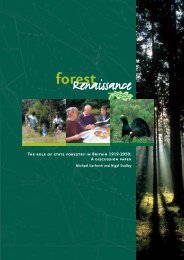
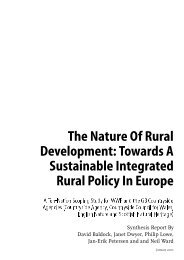
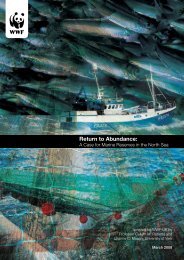

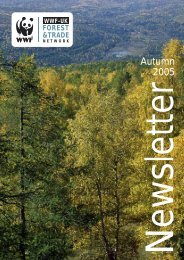

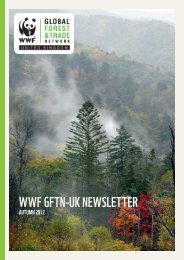
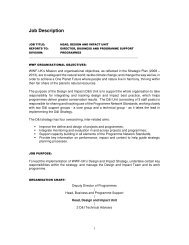
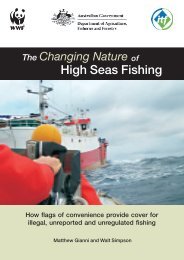
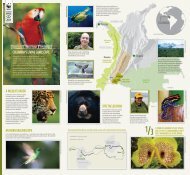
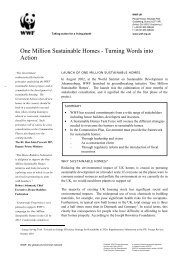
![[PDF] Causes for concern: chemicals and wildlife - WWF UK](https://img.yumpu.com/31929970/1/184x260/pdf-causes-for-concern-chemicals-and-wildlife-wwf-uk.jpg?quality=85)
